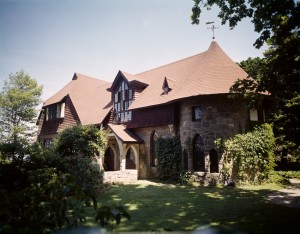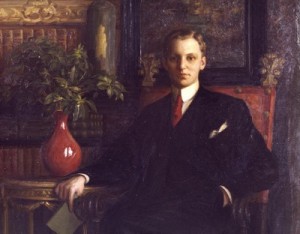 Henry Davis Sleeper was many things. He was one of America’s first professional interior decorators. He was a member of New England’s elite in the early twentieth century. He remained unmarried. He was gay. The details of this story that were routinely shared by tour guides at Sleeper’s magnificent home called Beauport (pictured to the left) in Gloucester, MA, included all those above except Sleeper’s sexual orientation. However, in 2008 an oral history with a cousin of Sleeper’s lover identified Sleeper as gay. From that point forward, explained Kenneth C. Turino, the manager of community engagement and exhibitions at Historic New England and an adjunct at Tufts University in the Museum Studies Department, tour guides have discussed Sleeper as a gay man.
Henry Davis Sleeper was many things. He was one of America’s first professional interior decorators. He was a member of New England’s elite in the early twentieth century. He remained unmarried. He was gay. The details of this story that were routinely shared by tour guides at Sleeper’s magnificent home called Beauport (pictured to the left) in Gloucester, MA, included all those above except Sleeper’s sexual orientation. However, in 2008 an oral history with a cousin of Sleeper’s lover identified Sleeper as gay. From that point forward, explained Kenneth C. Turino, the manager of community engagement and exhibitions at Historic New England and an adjunct at Tufts University in the Museum Studies Department, tour guides have discussed Sleeper as a gay man.
For years, audiences on tours of Sleeper’s house had asked if he was gay, the lack of historical evidence—Sleeper’s papers have most likely been destroyed—made it difficult to answer that question. No more. Turino explains that he and his staff “decided to interpret Sleeper as a gay man, not to define him but to contextualize him.” The Beauport House tour also works with Boston’s The History Project to bring the Lesbian, Gay, Bisexual, and Transgender community to Sleeper’s site. The History Project documents and preserves the LGBT community in a broad geographical area with Boston as its center.
These initiatives are part of a larger trend in public history including the National Park Service’s LGBT Heritage Initiative, a venture that, among other things, has begun mapping its work. Begun in 2010, this particular initiative has been the latest in the National Park Service’s attempt to reveal the diversity of American historical sites. According to the website for the Heritage and History Initiative, 70% of the new “properties presented to the Secretary of the Interior for designation as National Historic Landmarks since May 2011” have been characterized by their appeal to diversity.
I am thinking about such efforts because I have just participated in an annual public history workshop run by IUPUI’s director of the public history MA program, Phil Scarpino. The program has earned recognition as one of the best public history graduate programs in the country, in large part because of the work Scarpino does every year to get students into the field, mostly through paid internships, where they encounter a variety of questions that speakers discussed during the workshop. The world of public history is known to all historians and I imagine for many it resides in museums and historical societies. Of course we also know the work of public history through the Culture Wars and the controversies that seem to generate enough heat to make history relevant in one particular way—as a battlefield for that elusive, expansive thing we call popular memory.
Yet, most of what I heard at the workshop today had to do with the collision between the practical infrastructure of public history (from exhibits to budgets) and public engagement. It is the kind of collision that makes the story of Henry David Sleeper a kind of double narrative, one that has the practical aspect of tour guides fielding questions about the subject they present and a second that relates to the inability of public history to deal with the reality of the past. The idea that historians are trained to identify and search out groups on the margins and people who have been forgotten—sometimes forcefully and violently—can often be what motivates us to write. But the kind of growth public history has experienced lately also suggests some changes to the expression of historical research. For example, the reason I now know about Henry David Sleeper was that my new colleague, Jennifer Guiliano, a digital humanist, U.S. historian, and author of the forthcoming book Indian Spectacle: College Mascots and the Anxiety of Modern America (Rutgers UP), pointed us to the work of digital historians. These sites include:
Growing Apart: A Political History of Inequality
This last site, is a joint venture between Guiliano’s and her colleague Simon Appleford. Among the points that she made using her combined talents in digital and traditional history was that by employing software that is fairly easy to use, more people are able to present and see history in new ways. Of course, technology does not necessarily make historians more adventurous or braver, but it seems to me that the utility of mapping LGBT sites in the United States provides a stunning illustration (and one that is dynamic and developing) of the density of a history that had rarely received scholarly analysis much less public attention.
Presenting material that might be controversial was the topic of the keynote address, delivered by Marian Carpenter who is the Curator of Collections Management for the State of Delaware but has also worked for the National Civil Rights Museum in Memphis, TN and the Smithsonian. Carpenter has led a tour of the notorious Parchman Farm Prison in Mississippi and led investigations into robes worn by the KKK. She has curated collections of material culture that reflect racism in objects that range from toothpaste containers to piggybanks. In the end, both Guiliano and Carpenter suggested that public historians have an obligation to consider the material they work with, the audiences they work for, and the groups they elevate to public attention. And as historians move more and more routinely through the most public forum known in history—the internet—has it become apparent that we are all now public historians? And if this is obvious, does our collective venture in the digital world create new obligations to the discipline, the profession and our audiences?

0